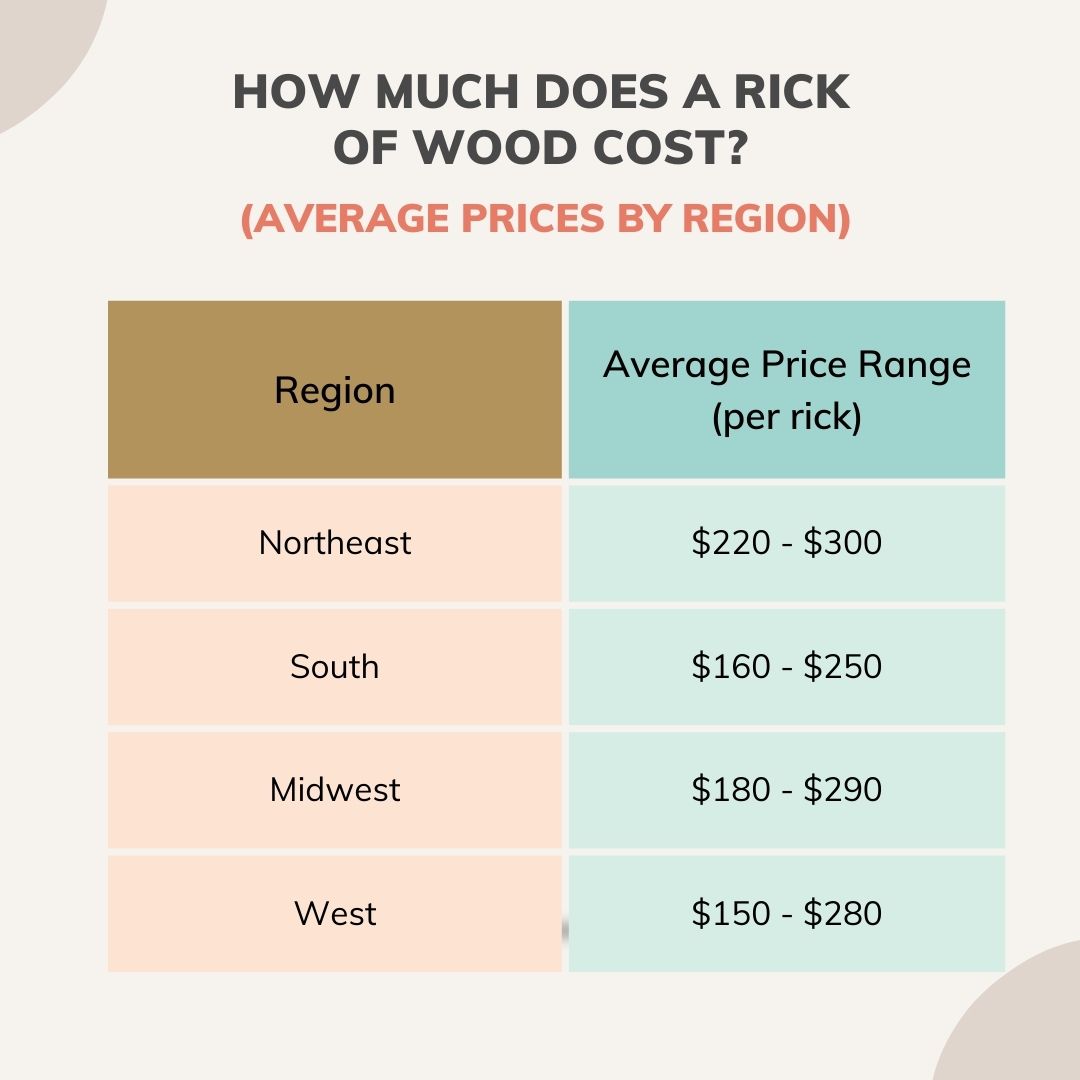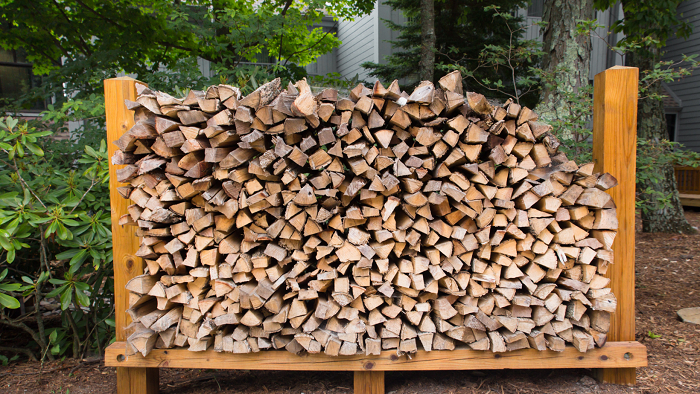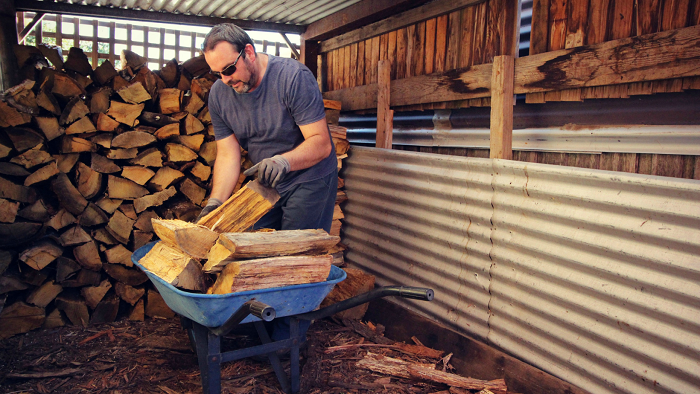Have you ever wondered, "How much is a rick of wood?"
This term, often used in discussions about firewood, holds great significance as a unit of measurement. Understanding what a "rick of wood" entails can be vital when it comes to heating your home efficiently.
A "rick of wood" is a standard unit for measuring firewood. It typically consists of a stack that is 8 feet long, 4 feet high, and one log deep.
This measurement ensures consistency when buying or selling firewood. Knowing the size of a rock helps you estimate the amount of wood needed to keep your home warm during colder months.
Using a rick of wood as a measurement is crucial for those who rely on wood-burning stoves or fireplaces for heating. It clearly explains how much firewood is required to maintain a comfortable temperature indoors.
This knowledge not only helps in planning ahead but also in budgeting for heating costs. However, it's important to note that the cost of a rick of wood and size can vary across states.
Different regions may have different market rates and regulations regarding firewood sales. Therefore, it's advisable to check with local suppliers for the most accurate pricing in your area.
In decision, understanding "How much is a rick of wood" is fundamental in efficiently utilizing firewood for heating purposes.
A "rick of wood" is a standardized unit of measurement within the firewood industry. It represents a stack of wood measuring:

This precision in measurement ensures consistency in the firewood market.
The dimensions of a rick of wood, specified as 8 feet by 4 feet by one log deep, make it a substantial source of firewood. This size makes it a popular choice for those relying on wood-burning stoves or fireplaces for heating.
It's worth noting that the term "rick" is sometimes used interchangeably with "cord" in specific regions. A cord, being a larger unit, consists of a stack measuring:
Therefore, distinguishing between a rick and a cord is crucial when procuring firewood to ensure you acquire the desired quantity.
The accurate measurements of a rick of wood, 8 feet in length, 4 feet in height, and one log deep, play a pivotal role for both buyers and sellers in the firewood market.
This standardization enables clear transactions and reliable estimation of firewood quantities.
Various types of wood come into play when considering firewood. Some of the notable varieties include:
Understanding these terms empowers consumers in their firewood purchases and aids in establishing fair transactions in the market.
The precise measurements of a rick and knowledge of firewood varieties contribute to a well-informed approach to wood procurement for heating needs.
When it comes to purchasing firewood, understanding the cost and how much is a rick of wood is crucial. Prices can vary significantly based on factors such as wood type, location, and additional services.
Here, we provide an overview of the average rick of wood prices across different regions, highlighting the notable variations.
In the Northeast, where winters can be particularly harsh, firewood is in high demand. As a result, the average cost of a rick of wood tends to be higher compared to other regions. Hardwoods like oak and maple are prevalent in this area, contributing to the slightly elevated prices.
Average Price: $220 - $300 per rick
In the Southern states, milder winters mean a lower demand for firewood. This generally leads to more competitive pricing. Pine and pecan are commonly used, and their abundance helps keep prices relatively affordable.
Average Price: $160 - $250 per rick
The Midwest experiences a range of climates, and firewood prices reflect this diversity. States with harsher winters, like Minnesota and Wisconsin, tend to have higher prices. Oak and hickory are popular choices, contributing to the moderate pricing.
Average Price: $180 - $290 per rick
The Western region, with its mix of climates, exhibits a wide range of prices.
Coastal states often have higher prices due to increased transportation costs. Inland states, like Idaho and Montana, tend to have more competitive prices. Varieties like fir and pine are prevalent.
Average Price: $150 - $280 per rick
Table: Average Rick of Wood Prices by Region
| Region | Average Price Range (per rick) |
| Northeast | $220 - $300 |
| South | $160 - $250 |
| Midwest | $180 - $290 |
| West | $150 - $280 |
These figures are based on average prices and can vary based on factors like specific location within a region, quality of wood, and additional services offered by suppliers.
It's advisable to obtain quotes from local suppliers for the most accurate pricing. Remember, understanding how much a rick of wood and rick of wood dimensions aids in making informed purchasing decisions.
We also recommend that you develop a clear differentiation between cord vs. rick of wood, as explained in earlier paragraphs, for a better firewood buying experience.
A "rick of wood" is a standardized unit of measurement for firewood, crucial for buyers and sellers alike.
It is precisely defined as a stack of wood that measures 8 feet in length, 4 feet in height, and one log deep. This meticulous measurement ensures consistency in the firewood market.
When considering the size of a rick of firewood, it's essential to emphasize its specific dimensions:
Length: 8 Feet
This measurement spans the longest side of the rick. It provides ample room for a substantial amount of firewood to be stacked.
Height: 4 Feet
The height of the rick contributes to its substantial volume. At 4 feet, it allows for a significant stack of firewood, making it an excellent choice for those relying on wood-burning stoves or fireplaces for heating.
Depth: One Log Deep
The depth of a rick of wood refers to the width of the stack, which is equal to the diameter of a single log. This ensures that the rick maintains its standard measurement.
Understanding the size of a rick of firewood is essential for accurate transactions and estimating the amount of firewood needed for heating purposes.
It's worth noting that while a rick is a standardized unit, the terminology can vary by region. In some areas, a rick may also be referred to as a "face cord."
In conclusion, familiarity with 'what is a rick of wood' and 'how big is a rick of wood' empowers consumers in their wood procurement for heating.
This standardized measurement unit ensures clarity for buyers and sellers regarding the quantity in question.

Determining the price of a rick of firewood involves considering several vital elements that significantly influence its overall cost. These factors play a crucial role in understanding the pricing dynamics:
The type of wood in a rick of firewood is a primary determinant of its cost. Hardwoods like oak and hickory tend to be pricier due to their high energy content and slower burning properties, whereas softer woods like pine are generally more economical.
The geographical location plays a vital role in firewood pricing. Availability, demand, and local market conditions vary from one region to another. Consequently, prices can fluctuate significantly based on these regional disparities.
The cost of transporting and delivering the firewood to the buyer's location is another important consideration.
The distance between the supplier and the customer, as well as any additional services such as stacking, can influence the final price.
The standardized measurements of a rick of wood, precisely 8 feet in length, 4 feet in height, and one log deep, impact its cost. A rick's specific dimensions contribute to its volume, influencing the quantity of firewood it contains.
Understanding these cost factors is crucial for both buyers and sellers. It not only aids consumers in making informed purchasing decisions but also allows sellers to establish fair pricing strategies.
By recognizing the significance of factors such as wood type, region, and delivery charges, individuals can navigate the firewood market effectively, ensuring they obtain the right amount of wood at a reasonable cost.
In essence, comprehending 'rick of firewood size' and 'rick of wood measurements' is pivotal in determining the overall expense.
This knowledge, combined with an awareness of the broader factors affecting cost, allows for a well-informed approach to procuring firewood.

Alt-Text: Rick-of-wood-supplier
When it comes to acquiring a rick of wood, individuals have several options to consider. Here, we'll explore various sources where you can purchase a rick of wood, including both local suppliers and online options.
Local firewood yards and stands are excellent places to find a rick of wood. These establishments often carry a variety of wood types, allowing customers to inspect the quality before making a purchase.
Many landscaping and garden centers also offer firewood for sale. They may have a selection of seasoned wood and can provide advice on the best type of wood for specific heating needs.
Companies that specialize in tree removal and trimming often sell firewood as a byproduct of their operations. This can be an economical option, especially if the wood is sourced locally.
Online marketplaces like Amazon, eBay, and specialized firewood websites offer a convenient way to purchase a rick of wood. Buyers can browse through various options and have the wood delivered to their doorstep.
Websites like Facebook Marketplace often have listings for firewood. Buyers can find local sellers and arrange for pickup or delivery.
There are dedicated online retailers that specialize in selling firewood. These platforms may offer a wide selection of wood types and allow customers to choose specific quantities and delivery options.
Local farmers' markets or community events may feature vendors selling firewood. This can be a great way to support local businesses and find high-quality firewood.
It's important to consider factors such as wood type, seasoning, and delivery options when making a purchase. Additionally, always verify that the seller adheres to sustainable and legal practices in sourcing their firewood.
In conclusion, whether you opt for a local supplier or choose to buy online, knowing where to find and purchase a rick of firewood ensures you have a reliable source for keeping your home warm during colder months.
When it comes to procuring a rick of firewood, there are several strategies to ensure you get the best value for your investment. Here are some valuable tips to consider:
Familiarize yourself with the precise measurements of a rick of wood. Knowing that it is 8 feet long, 4 feet high, and one log deep will help you accurately assess the quantity and quality of the firewood you are purchasing.
Examine the rick to ensure it meets the standard measurements. A properly stacked rick should align with the specified dimensions, providing you with the expected amount of firewood.
Seasoned firewood, which has been properly dried and cured, burns more efficiently and produces less creosote buildup. While it may be slightly more expensive, it offers better value in terms of heat output and reduced maintenance.
Buying from local suppliers can often be more cost-effective, as transportation costs are minimized. Additionally, local suppliers may offer competitive prices and a more personalized buying experience.
Purchasing a larger quantity of firewood, such as a cord or multiple ricks, can often lead to cost savings. Many suppliers offer discounts for bulk orders.
Keep an eye out for seasonal promotions or discounts. Some suppliers may offer lower prices during off-peak seasons, providing an opportunity to get better value for your purchase.
Before finalizing the purchase, inspect the firewood for signs of insects, mold, or excessive moisture. High-quality firewood will be clean, well-seasoned, and free from defects.
Inquire if the supplier offers additional services like stacking or delivery. While there may be an extra cost, it can save you time and effort in preparing the firewood for use.
By following these tips and considering the measurements of a rick of wood, you can make a well-informed and cost-effective firewood purchase. Remember, investing in high-quality firewood ensures you get the most value in terms of heat output and overall satisfaction.
In conclusion, understanding 'how much is a rick of wood' and implementing effective budgeting strategies are paramount when purchasing firewood. Ensuring you receive the correct quantity of well-seasoned wood at a reasonable cost is crucial for a comfortable and cost-efficient heating experience.
Key takeaways include knowing the measurements of a rick of wood, considering seasoned firewood for efficiency, and exploring local suppliers for potential savings. Additionally, bulk purchasing and seasonal discounts can provide opportunities for further budget optimization.
By prioritizing budgeting, you not only make a wise financial decision but also guarantee a warm and cozy environment during colder months. Remember, a well-planned firewood budget leads to a more comfortable and economical heating solution for your home.